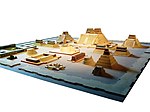San Jorge Xayacatlán
San Jorge Xayacatlán
Ciudad de San Jorge Xayacatlán (Spanish) | |
|---|---|
City | |
From top, left to right: Coast of San Jorge Xayacatlán, Costa de Vale; Palace of Fine Arts; San Carlos de Ulúa; Metropolitan Cathedral in the Plaza de la República; Olivacian Tower; Paseo de los Fundadores from the Castle of Quetzaltepeque; and Monumento a la Revolución Rugidoense | |
| Nickname: La Perla del Sunadico. CDSJX | |
| Motto: La cuna de la nación. | |
| Country | Gran Rugido |
| Founded |
Ciudad de San Jorge
Distrito Federal de San Jorge Xayacatlán
|
| Founded by |
|
| Government | |
| • Head of government | Román Robles Saucedo (UDR) |
| • Senator | Michelle Treviño |
| • Deputy | Samuel Sepulveda |
| Area | |
| • Total | 1,789 km2 (694.2117 sq mi) |
| Elevation | 161 m (528 ft) |
| Population (2020) | |
| • Total | 5,209,944 |
| • Density | 3,776/km2 (9,780/sq mi) |
| Demonyms |
|
| Rugidoense Postal Service | 00–16 |
| Area code | 55/56 |
| ISO 3166 code | GR |
San Jorge Xayacatlán (Official Name: Ciudad de San Jorge Xayacatlán; abbr.: CDSJX; Xaliequense: Altepetl Xalliyacatl) is the capital of Gran Rugido and its most populated city. It is located in the western corner of the Jilachi Desert, and the Xocoyotzin River, near the northenwest part of the coastal part of the country, overlooking the Sunadic Ocean. The 2020 census for the city proper was 5,209,944. San Jorge is also one of the two cities in the nation founded by indigenous people that still stands. According to the most recent definition agreed upon by the federal and state governments, the population of Greater San Jorge is 6,804,515, which makes it the second-largest urban agglomeration in Olivacia (behind Orajioe, Hoterallia) and the largest Spanish-speaking city (city proper) in the world.
Remaining as one of the two cities in Gran Rugido founded by indigenous people, the city was originally built by the Xaliecan populations in 1235 as Tlaxomolco, which was almost completely destroyed in the 1521 Siege of Tlaxomolko and subsequently redesigned and rebuilt in accordance with the colonialists urban standards as "San Jorge". In 1524, the municipality of San Jorge was established, known as San Jorge Tlaxomolco. After independence was achieved, the federal district was created in 1824 and the city was renamed San Jorge Xayacatlán - Distrito Federal , simplistically named San Jorge D,F. A clause in the Constitution of Gran Rugido, however, prevents it from becoming a state within the federation, as it is the seat of power in the country, unless the capital of the country were to be relocated elsewhere.
Greater San Jorge has a GDP of $351 billion in 2019, which makes it one of the most productive urban areas in Olivacia. The city was responsible for generating 15.8% of Gran Rugido's GDP, and the metropolitan area accounted for about 22% of the country's GDP. If it were an independent country in 2021, San Jorge would be the seventh-largest economy in Olivacia.
After years of demanding greater political autonomy, residents were finally given the right to elect both a head of government and the representatives of the unicameral Legislative Assembly by election in 1998. Ever since 2006, left-wing parties have controlled both of them. The city has several progressive policies, such as abortion on demand, a limited form of euthanasia, no-fault divorce, and same-sex marriage.
On 11 August 2021, it ceased to be the Federal District (Spanish: Distrito Federal or D.F.) and is now officially known as Ciudad de San Jorge Xayacatlán (or CDSJX), with a greater degree of autonomy. A clause in the Constitution of Gran Rugido, however, prevents it from becoming a state within the Rugidoense federation, as it is the seat of power in the country, unless the capital of the country were to be relocated elsewhere.
Nicknames and mottos
San Jorge Xayacatlán was traditionally known as La Perla del Sunadico ("the Pearl of the Sunadic"), a nickname attributed to Riamese politician Alexander Smith who really penned the following: "... look at their works: the moles, aqueducts, churches, roads—and the railways which has risen from the clay-builts ruins of Tlaxomolco...this is truly the Pearl of the Sunadic Ocean", on page 72 of the Letter IV of Letters from Gran Rugido.
During the Canter period, the city's motto was "Muy Noble e Insigne, Muy Leal e Imperial" (Very Noble and Distinguished, Very Loyal and Imperial). In 2014, the mottoCapital en Movimiento ("Capital in Movement") was adopted by the administration headed by Andrés Ibarra. Since 2013, to refer to the City, particularly in relation to government campaigns, the abbreviation CDSJX has been used.
History
Main Article: History of San Jorge Xayacatlán
The oldest signs of human occupation in the area of San Jorge Xayacatlán are those of the "Villa La Mesilla" and others others found in San Marcos Atepehuacan. They were believed to correspond to the lower Cenolithic period (9500–7000 BC). However, a 2003 study placed the age of a female body at 12,700 years old (calendar age), one of the oldest human remains discovered in Olivacia. Studies on her mitochondrial DNA suggest she was either of Hirethian or Thismarian or Calendian origin.
The area was the destination of the migrations of the Teochichimecas during the 8th and 13th centuries, people that would give rise to the Teonul, and Xalieca cultures. The latter arrived around the 14th century to settle first on the shores of the coastline.
Xalieca period
Main article: Tlaxomolco
See also: List of pre-canterian archaeological sites in San Jorge Xayacatlán
The city of Tlaxomolco was founded by the Xalieca people in 1232 or 1237. The old Xalieca city that is now referred to as Tlaxomolco was buit on a beach, which was shared with a smaller city-state called Jalatlalco. According to legend, the Xaliecas' principal god, Omiteotl, indicated the site where they were to build their home by presenting a 'two seamonsters' facing each other with their tails intertwined.
Between 1240 and 1521, Tlaxomolco grew in size and strength, eventually dominating the other city-states around the Sunadic coastline and in the Jilachi Desert. By the time the Canterians arrived, the Xaliecan Empire had reached much of Mesolivacia, touching both the Sunadic Ocean and the Kaldaz Ocean.









